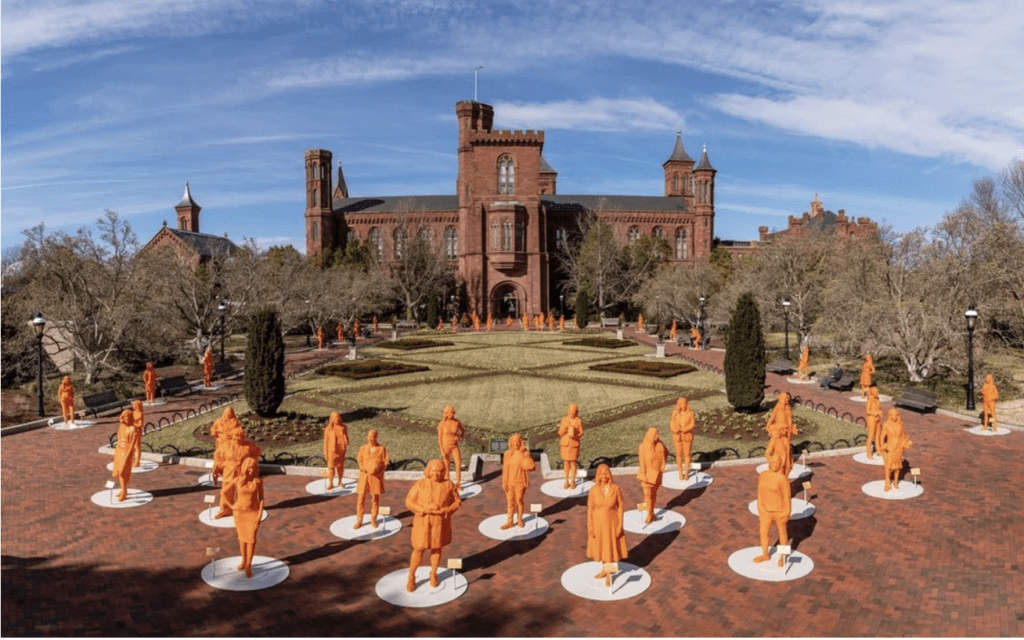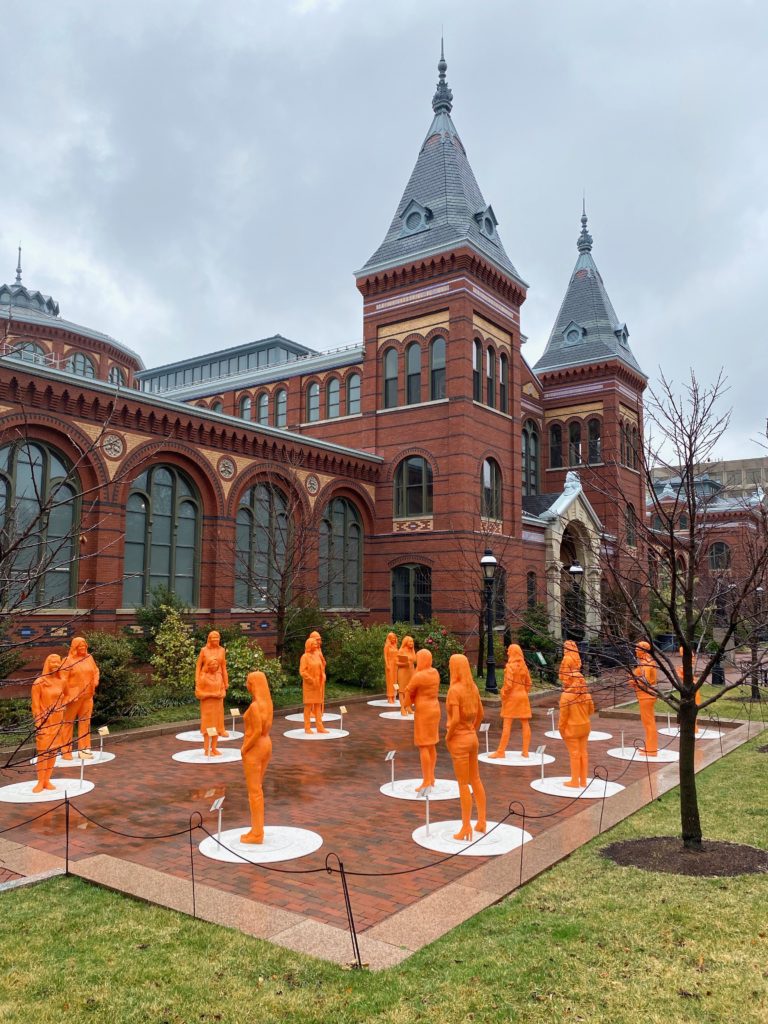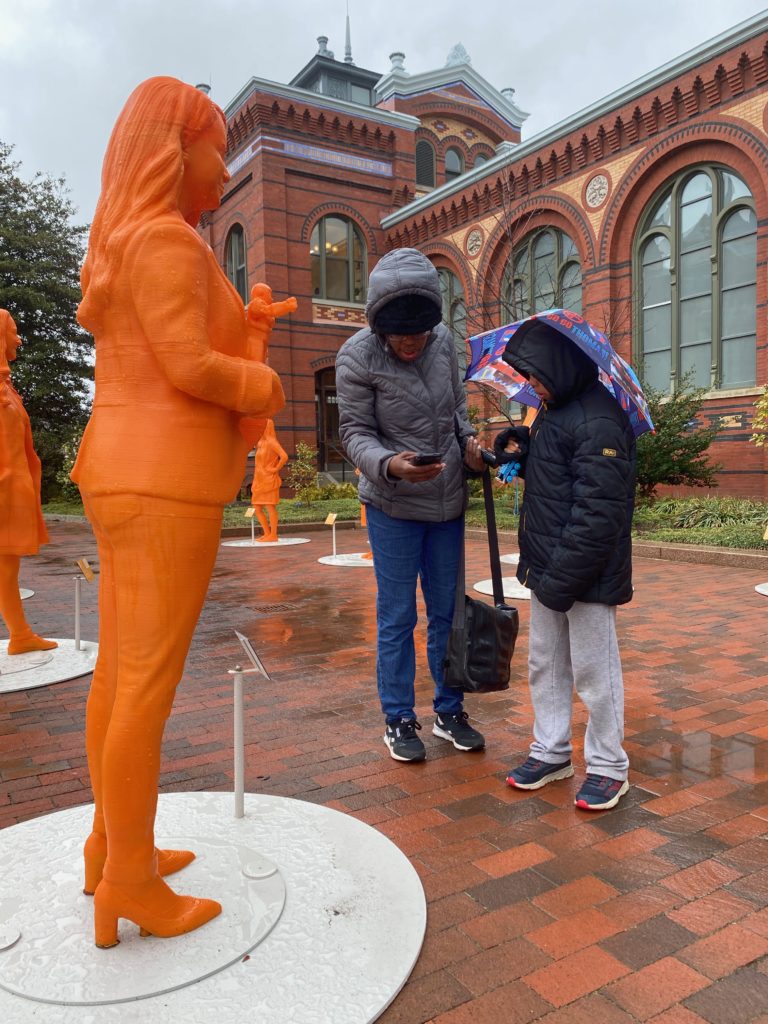Smithsonian Honors Female Scientists With 120 Statues on National Mall
By • March 10, 2022 0 2392

Outdoor sculptural installations are often visually arresting, thought provoking, yet ambiguous in meaning.
Not so, the “#IfThenSheCan” exhibit – the largest collection of life-sized 3-D printed statues of real women ever assembled together for display – unveiled to the public on Saturday, March 5 at the Smithsonian Gardens on the National Mall. While the exhibit’s 120 sculptures are deeply captivating and fascinating, their meaning is crystal clear, direct and powerful.
This year, in honor of Women’s History Month and in tandem with the Smithsonian Arts and Industries’ “FUTURES” exhibit, the month of March has also been dubbed by the Smithsonian as “Women’s Futures Month.” And the “#IfThenSheCan” exhibit has an unambiguous purpose: to commemorate outstanding women in the fields of science, technology, engineering and math (STEM) in order to inspire more young girls to pursue STEM careers.
“Calling all citizen scientists, do-gooders, plant lovers, activists, advocates, dreamers, and creators!” the advocates of Women’s Futures Month declared. “Join us in March 2022, when the Smithsonian shakes up Women’s History Month with a new Women’s Futures Month: a forward-looking celebration of the power of women and girls in STEM to shape a better world.” (Si.edu.womensfuturesmonth)
According to the exhibit’s website, “women constitute half of the college-educated workforce but make up just twenty-five percent of the STEM industry.” (Ifthenexhibit.org.)
Developed by IF/THEN, an initiative of the Lyda Hill Philanthropies “designed to activate a culture shift among young girls to open their eyes to STEM careers,” the “#IfThenSheCan” exhibit is based on the concept that if a young girl or woman “can see it … then she can be it.”
So, the project selected 120 highly accomplished women to serve as “STEM ambassadors” from which 3-D printed, life-sized sculptures would be created. The subjects represented a “diverse coalition of contemporary women STEM innovators and role models leading a variety of fields, from protecting wildlife, discovering galaxies, building YouTube’s platform, to trying to cure cancer.”
The media and sculptural techniques selected for the project embrace and exemplify STEM technologies at work. Joslyn Elliot, the 3-D printing and project manager for the exhibit, oversaw the high-tech process of creating each statue in a matter of a few weeks per piece.
One STEM Ambassador, Aerospace Engineer Sydney Hamilton, shown on video on the Smithsonian’s website, holds “tools of her trade” and cheerfully stepping into a photo booth equipped with close to 200 cameras. Later, the photos are stitched together to create a life-sized 3-D model of Hamilton. Once the industrial strength 3-D printer receives the “tool package” from Hamilton’s photo shoot, it begins building up layers of acrylic gel that “harden and cure when exposed to ultraviolet light.”
In the finishing touches, the dried 3-D printed acrylic model is then spray-coated with a bright orange finish, somewhat like car paint, designed for durability in extreme weather conditions outdoors. The bright orange sculptures appear to suggest to viewers that each sculpture is to be noticed, observed and taken fully into account – somewhat like an orange traffic cone calling for a driver’s attention.
On display, each statue is mounted upon a flat halo-evoking white metal sphere with a mounted plaque providing viewers a QR-coded link to an online introduction to each figure’s real life biographical details and story. By scanning with their smartphones, viewers can explore the personalities and careers of each of the women “whose jobs include shark tagging, designing fashion, and training Olympic athletes,” and more. Instead of a traditional inanimate bronze, metal or marble tribute with a stationary plaque, these sculptures jump to life when the viewer connects to the online world, the world of the future.
Smithsonian Secretary Lonnie Bunch said in a statement: “These striking 3D-printed figures of remarkable women in STEM careers help us celebrate the incredible impact women continue to make on vital scientific endeavors… This exhibition highlights how a more diverse, more inclusive workforce will strengthen our shared future.”
On a drizzly, cold March Wednesday, viewers – some with umbrellas — examined a set of the “#IfThenSheCan” sculptures next to the Smithsonian’s Arts and Industries Building, scanning the QR codes with their phones and examining the objects carried by each figure as well as the varieties of facial expressions depicted.

The Arts and Industries Building hosts a smaller collection of statues from the “#IfThenSheCan” exhibit, on display through March 27. Photo by Chris Jones.
Wearing a raincoat, 10 year-old Minnesotan, Madison McDonough, was visiting the National Mall with her family. Strolling through the exhibit cheerfully, Madison shared her thoughts. “I think it’s really cool because a bunch of girls from all over the world get to share what they do and how they can change the world,” she said. “And I think Women’s History Month is awesome.”
Angela Weaver of Washington, D.C., was out on a “field trip” with her two homeschooled young sons, Jacob and Joshua. “I was just using a QR reader on my phone to look up Allie Miller here [points to statue] who’s some kind of innovator in AI, artificial intelligence,” Weaver said. Her son Joshua, in early elementary school, was attracted to the sculpture of Miller because of the little robot she was holding and because “orange is [my] favorite color.”

Josh Weaver and his mom, Angela Weaver, use the QR codes to scan information about AI innovator Allie Miller whose statue is before them. Photo by Chris Jones.
Joshua had asked “aren’t there some scientists who are men?” Weaver replied, “Don’t worry, there are lots of them. But this is Women’s History month, so we’re going to see statues of some women scientists up here.”
Over the weekend, the Arts and Industries Building invited visitors “of all ages and gender expressions to dream big and see themselves as scientists-in-the-making.” Several women scientists and inventors who modeled for the statues appeared in person. A career day and “Science Family Day” were also held.
On March 7, separate statues from the exhibit were dispatched for exhibition to a variety of Smithsonian locations including the AIB, the adjacent Enid A. Haupt Garden, the Smithsonian Castle, the Museum of Natural History, and the National Air and Space Museum.
The “#IfThenSheCan” exhibit runs through March 27. For more information, visit https://ifthenexhibit.org/about/.

